After I completed the five year Active Duty obligation, I joined the Army Reserve. I soon found out about the Military Academy Liaison Officer Program, run by the Admissions Office at West Point, a largely unpaid program but very fulfilling. I also found a home with the Army Corps of Engineers, New York District as an Individual Mobilization Augmentee, training in Syracuse, West Point, and New York City. I worked in Rochester, NY for the DuPont Company, Photo Products Division. I realized fifteen years later that digital photography was eventually going to supplant silver halide film, and I was going to have to find another job. Twenty years to the day that I graduated from West Point, I started working as a Department of the Army Civilian as the Associate Director of Admissions for Plans and Programs.
Halfway through the 1992-93 Admissions Cycle, the Superintendent of West Point told the Admissions Office that he wanted to have no more than a certain number of cadets admitted that year. He undoubtedly got his marching orders from higher up. That was way too late, the Early Action Admission Cycle had already been completed, and by Law, vacancy fills had to be selected. Admissions did what it could, but that day, eight more young men and women reported than the Superintendent wanted. My bosses were very upset, not wanting to report that they had failed in this impossible mission.
The first thing to do at In-Processing on Reception Day 1993 was to sign the Oath of Office, making the new cadets members of the Armed Forces. That had been the last thing to do on my Reception Day in 1965. Then there was the drill of reporting to the Man in the Red Sash, who told people where to go next.
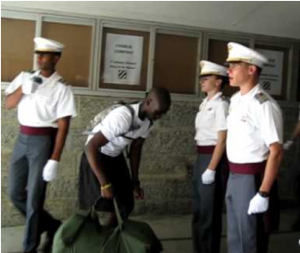
Eventually, on that day in 1993, three New Cadets were determined to be unable to complete the training because of physical problems encountered prior to arrival or during that day. They were sent to the Admissions Office to await further instructions.
I witnessed a heated discussion between the Staff Judge Advocate (the Legal people), a Major and a Captain; the Medical Department Commander; the Director and Deputy Director of Admissions; and the Master of the Sword (who ran the Department of Physical Education). Those four were full colonels. The legal people said that once they signed their names on that document, they were cadets. The Medical Department Commander didn’t take sides, but said he could treat them. The other three maintained that since they couldn’t do the training, they shouldn’t be allowed to go to the Swearing-In Ceremony, and since they wouldn’t be raising their right hands to take the Oath, they weren’t cadets. I was the only non-uniformed person there, a Lieutenant Colonel in the Reserves at the time, but a Department of the Army Civilian as far as they were concerned.
The colonels decided to give Letters of Assurance to the three, stating that if they received new nominations for the next class, admission was assured. I had to deliver that message to them and their parents. I very much wanted to confront the colonels with the fact that I didn’t go to my own Class of 1969 Swearing-In Ceremony. I couldn’t get in a word, but I knew better.
When I was first measured at the start of senior year in high school as a candidate for West Point, I was under 5 foot 4 inches tall. The height requirement at the time was 5 foot 6 inches to 6 foot 6 inches; that could receive a waiver to 5 foot 4 inches on the small side and 6 foot 8 inches on the tall side. Since I was too small, I was disqualified medically, but there was a provision that I could be re-measured closer to the time of admission for the class of 1969—July 1 of 1965.
Therefore, I embarked on a program of stretching exercises proposed and aided by several members of the Department of Physical Education at West Point. I hung, I stretched my back, I stretched my Achilles tendon and calf muscles. I did everything I could to get more distance between the parts of my backbone. I found out that the best time to be measured was first thing in the morning. When the big day came, June 15, the Army Doctor pronounced that I came in at 5 foot 4 and 1/8 inches. So with the waiver, I was qualified. A week later, at a Testimonial Dinner for my father, who had just been promoted to Brigadier General, my Representative in Congress, Peter W. Rodino, made the announcement that I had been offered admission to West Point.
My first day as a cadet started out fine, as Newman Kopald, my best friend in Highland Falls High School, just south of West Point, drove me from the Lusk housing area on post down the hill to the Central Post Area where the cadet barracks are. I kind of knew what to expect—it was going to be a tough day with a lot of harassment. We were New Cadets, not yet Cadets until the end of Beast Barracks and the Acceptance Parade. We were assigned to a New Cadet Company and a room, given haircuts, a Physical Aptitude Exam, shots, a meal, instruction in marching, and a whole lot of uniforms, bedding, and a trunk. The man in the Red Sash directed everything. He would look at the tag attached to our gym shorts, once we had them, and direct us to the next Station.
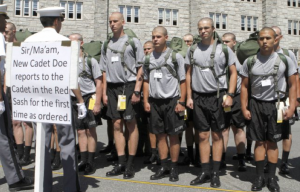
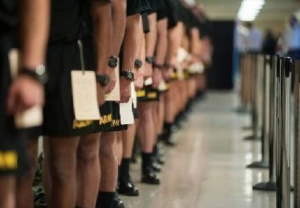
In early afternoon I was directed to go the Cadet Store to be fitted for a pair of tropical worsted gray trousers—the summer version worn with a white short-sleeved shirt. We were issued the winter version in the fall. A tailor held up a pair of trousers by my side, measured the length and said to come back at 1630 (4:30PM) to pick them up. When I came back, someone found my shortened pair, held them up by my side, and pronounced them a good fit.
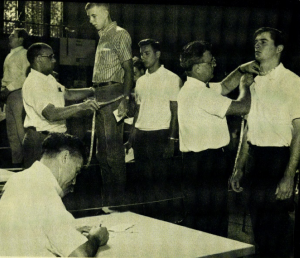
I tried to put on my uniform for the Swearing-In Ceremony about an hour later, and found that the trousers were about 26” waist size, and I had a 30” waist. I somehow got into them, but I could hardly breathe. I went to the formation, where the upperclassmen were inspecting us to make sure that we were ready to go. The New Cadets with the upperclassman who were detailed to lead them during the next month were to march onto the Plain and be administered the Oath of Office, which was supposed to officially enter them into the Army.
The temperature this day had been close to 100 degrees, and the humidity had been almost 100 per cent. Now with my waist cinched up too tightly, I was about to pass out when the upperclassman came to inspect me. He immediately saw that instead of going to the Plain with the rest of my class, he should take me to the hospital. I was given some pill, and—I kid you not—a prescription that said those trousers should be left loose around me, with the fly unzipped.
So 1136 New Cadets raised their right hands and took the Oath of Office out on the Plain. I did not.
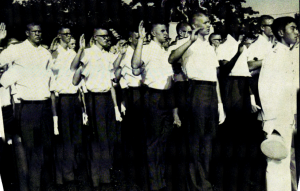
But, I did have supper with my Company. Then after supper, we went to the North Auditorium of Thayer Hall where we actually signed Oaths making us members of the Army.
I had been at West Point since fifth grade, and my parents as well as many other observers expected to pick me and my five classmates from Highland Falls High out of the eight formations of New Cadets. Two and a half weeks later, after Sunday Mass, the Pastor said to me that he saw me at the Swearing-In Ceremony. I had to tell him that he had mistaken someone else for me.
I was possibly the shortest cadet in the Corps, although there were some others who also had been waivered, and people noticed me right away. One upperclassman stood me up against a pillar in the Cadet Mess Hall, and stated that I was three and a butt blocks tall on the center pillar of the mess hall. (A butt means a part of something.) He told me that whenever anyone asked me how tall I was, I was to recite that fact.
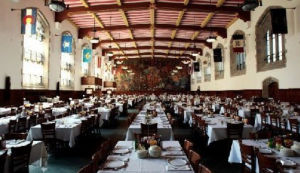
The flags of the fifty states hung in various sections of the Mess Hall. Below each flag, at about the height of an average person, was a little plaque with the name of the state. Above the center pillar hung the flag of Maine with its corresponding plaque. The plaque was about four inches above me.
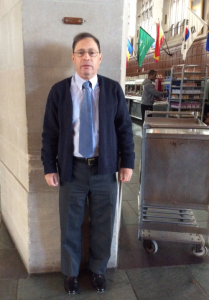
He then told me that if someone questioned my height and wasn’t satisfied with the first answer, then I was to say that I was four inches shorter that Maine. As you can imagine, no one was satisfied with my responses, and I endured a lot of grief because of that.
The next time we wore those tropical worsted gray trousers was at the very end of July. I had lost 19 pounds. Wonder of wonders, they fit perfectly. That was also the day I was measured for a Full Dress Coat, the one with all the buttons down the front. Despite my protestations to the contrary, saying that I would gain a lot of weight back, the tailors said
that they knew what they were doing. The next day, I was put on a weight-gain table for all meals. Sure enough, neither the trousers nor the coat fit when I tried them on again, and both had to be altered. Even though alternations were needed then, I never again needed medical instructions for wearing my gray trousers.
I knew better in 1993!